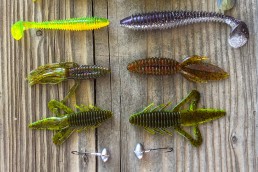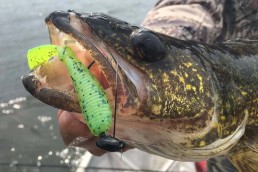Fatten it up for Fall: Fall Bass Fishing Patterns
SHARE THIS POST
This time of the angling season is one of transition. While plenty of warm, t-shirt wearing days are still on the calendar, you can feel change in the air. Warm days are followed by much cooler nights than a month or so ago. Trees and plants are showing the effects of the summer heat, and most foliage is at least in the beginning stages of turning color. Abrupt weather changes seem a little harsher, with more drastic cold fronts moving through the area; as an outdoor enthusiast, you definitely sense these changes.
While we sense the coming of fall, and eventually winter, by the lowering daily temps and the dwindling daylight hours, we need to be cognizant of transitions occurring in the underwater world as well. While cold-blooded fish don’t feel a chill due to dropping water temperatures, their bodies still sense the change. This, in turn, affects their habits and behavior heading into the coldwater periods that lie ahead.
Bass, and all species for that matter, feed quite heavily during this time period. Their bodies use the residuals of their heavy appetite to store fat, which will be essential to surviving the lean, colder winter months ahead. With such an increase in a bass’s appetite, the need for larger portions of food will aid in the bass’s ability to put on the pounds, so to speak. Nature has a way of providing the food and the right meal sizes to accomplish this intentional gluttony.
By this time of year, most of the species bass feed on have reached much larger sizes, as opposed to their rather bite-sized portions from early spring thru summer. For example, bluegills—a staple in most bass’s diet—have grown from quick-moving and easily-hidden fry size fish, to much-easier-to-find-and-catch juvenile specimens, which are certainly more filling for bass appetites. Shad, another species on the bass menu, have grown much the same over the warm summer months, providing feeding bass with a larger portion opportunity. Crayfish in many waters are a significant food source for bass as well; they, too have been increasing in size during the warm-water months.
No matter what the food source, whether it is swimming on the surface, schooling in between or crawling along the bottom, it now presents the bass with a much larger profile, and much larger food portion. So being a sort of “match the hatch” kind of angler, you probably already know where I’m headed with this information. Whatever bait you are throwing this time of year, you need to increase the size of your presentation to appeal to the seasonal needs of bass.
Before we discuss the actual concept of size-increase of the baits you will be throwing during this time period, let’s look at some possible suggestions for what types of baits to throw during the transition months ahead.
The summer months are a fun time to experiment with various types of baits, techniques and presentations. Bass are extremely active during this period, and just about anything presented or offered will catch their eyes. But, as waters begin to cool, certain baits have less effectiveness than they once had during the warm-water months. As an example, frog fishing seems to die out once the waters start cooling considerably; it’s totally natural, as frogs are preparing for the upcoming winter months and are no longer present on the banks. Surface baits in general are less effective the colder the water gets.
My bait selection definitely becomes more limited at this time of year, as I will concentrate on baits that have a higher-percentage appeal to a bass’s desire to leave the dinner table full. During this time of year, bass are not as concentrated in larger schools as they will be in just a couple months, roving feeding grounds in smaller packs or even as individuals. Your ability to cover water during this time of year is essential to your success, so search or power type approaches that cover water quickly will increase your odds.
My first bait to tie on for most waters, unless I have definite knowledge of a more effective presentation, will be a crankbait. I will not be running deep divers yet, preferring to work baits that run in the 4- 6-foot range, which are pretty effective for most waters here in the Midwest. I know that many bank bassers work crankbaits pretty much all season, and I usually have one tied on, or at least close at hand myself. But I will be increasing bait size considerably at this point of the season.
Are you enjoying this post?
You can be among the first to get the latest info on where to go, what to use and how to use it!
Throughout most of the summer, I normally throw crankbaits, mostly squarebill designs, in that 2-1/2- to 2-3/4-inch range. But now, I will be selecting baits in the 3–inch-plus range to provide bass with larger profile baits. For example, I use Strike King’s 1.5 and 2.5 Square Bills for the majority of my fishing throughout the year. But as waters cool in fall, I switching over to the 4.0, which is a 3-inch bait. At times, if I’m relatively certain big bass are present, I’ll go on up to the 8.0 version, which measures out at 3 1/2 inches.
You might look at the actual bait lengths here, and feel there is not much difference in size. But there is a huge difference in bait thickness and profile in the larger sizes. There are other bait companies with large crankbaits as well, but few of them have the square bill model in larger sizes.
Probably splitting my time between two baits during this time of year, my second bait is a plastic swimmbait, paddletail bait or whichever term you refer to it being. These baits are a bit subtler in action, and you can vary the retrieve to change depths, or let them fall or swim down. There are certainly lots of options with these baits.
For plastic baits, these swimmers put out quite a bit of vibration from their round tails—a definite fish-attracting thump at a slow retrieve rate, when conditions call for less commotion from your bait. While 3- to 4-inch models are often the normal size for much of the year in the waters I frequent, come early fall, baits in the 5- to 6-inch range are my go-to baits. Once again, the actual bait length increase doesn’t tell the story. Five- to 6-inch baits have a whole lot more plastic to entice feeding fish.
When I follow the water column all the way down, and am looking for a bait that stays on the bottom, I’ll add a large plastic crawfish, or a creature (or similar) bulky-type bottom crawler to my rotation. Remember, bass can literally be found anywhere from top to bottom at this time of year, so don’t overlook working bottom areas that could possibly have feeding fish.
This time of the season, my goal is to work the bottom—but more open-water bottom rather than in dense-cover type areas. I like to crawl a large plastic presentation across mud, silt, sand, gravel—whatever is available—that is not covered with heavy weeds or wood, giving bass a visual of some type of creature moving across the bottom. Plastic worms can be used, but most craw- and creature-type baits have multiple flapping appendages, which draw more attention from cruising bass.
My favorite way to rig these baits is on a heavier-type football head jig with no fiber weedguard, like those on your flippin’ jig. Yes, a flippin’ jig will work; it’s really just personal preference for me. Rig the bait however you like; just make sure it keeps good contact with the bottom.
There are certainly other variations of baits for this time of year. I can’t cover them all. But if you don’t already practice this concept of matching larger-than-normal type baits to match the feeding habits of bass this time of year, consider giving it a try in the months ahead.
Bass are staging to fatten themselves up for a couple of months spent under the ice. Give them a hand in trying to accomplish their mission. This could be your best chance of the season to do battle with trophy-sized bass!
MWO
SHARE THIS POST
Did you enjoy this post?
You can be among the first to get the latest info on where to go, what to use and how to use it!
Dan Brozowski
Passion for angling drives Dan Brozowski to the water’s edge virtually any chance he gets. Although passion cannot be measured, weighed, or recorded, it can be shared. He does this through his writing and while on the water. If you have any questions or comments for Dan, you may contact him at: onthebank@att.net.



